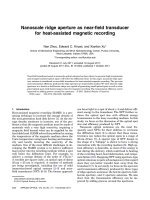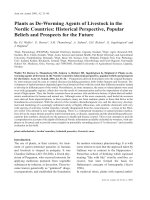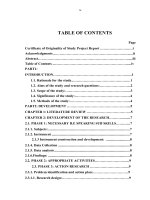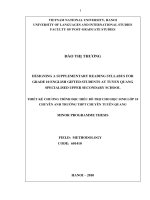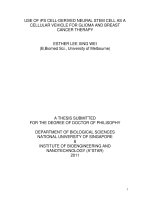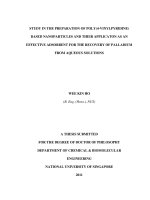The crude plant juices of desert plants as appropriate culture media for the cultivation of rhizospheric microorganisms
Bạn đang xem bản rút gọn của tài liệu. Xem và tải ngay bản đầy đủ của tài liệu tại đây (721.34 KB, 9 trang )
Journal of Advanced Research (2012) 3, 35–43
Cairo University
Journal of Advanced Research
ORIGINAL ARTICLE
The crude plant juices of desert plants as appropriate
culture media for the cultivation of rhizospheric
microorganisms
Eman H. Nour a, Mervat A. Hamza a, Mohamed Fayez a, Mohamed Monib a,
Silke Ruppel b, Nabil A. Hegazi a,*
a
b
Faculty of Agriculture, Cairo University, Giza, Egypt
Leibniz-Institute of Vegetable and Ornamental Crops, Grossbeeren/Erfurt e.V., Germany
Received 26 October 2010; revised 22 December 2010; accepted 4 March 2011
Available online 13 April 2011
KEYWORDS
Desert plants;
Plant juices;
Rhizospheric microorganisms;
Diazotrophs;
Culture media;
North Sinai
Abstract The exclusive use of plant juices, not as a mere supplement to synthetic culture media, for
culturing rhizospheric microorganisms (RMO) is introduced here. Juices were prepared from desert
(Mesembryanthemum crystallinum L., Zygophyllum album L., Carpobrotus edulis L.) as well as
cultivated (Trifolium alexandrinum L., Beta vulgaris L.) plants. Colonies of RMO (Azospirillum
brasilense, Enterobacter agglomerans and Klebsiella pneumoniae) nicely developed on surfaceinoculated agar plates prepared from crude and diluted juice of M. crystallinum (ice plant). Furthermore, hundreds of RMO colonies developed on various standard culture media were replicated
(>90%) on agar plates of different plant juices. RMO cells grew nicely in liquid ice plant juice, with
doubling times comparable to those grown in the reference culture medium. RMO populations resident in various host plants were able to develop on culture media prepared from homologous and
heterologous juices. The application of a thin semi-solid overlay agar on the surfaces of inoculated
agar plates significantly increased the recovery of micro-colonies on agar plates, particularly those
prepared from plant juices.
ª 2011 Cairo University. Production and hosting by Elsevier B.V. All rights reserved.
* Corresponding author. Tel./fax: +20 2 25728483; mobile: +20
0122975527.
E-mail address: (N.A. Hegazi).
2090-1232 ª 2011 Cairo University. Production and hosting by
Elsevier B.V. All rights reserved.
Peer review under responsibility of Cairo University.
doi:10.1016/j.jare.2011.03.002
Production and hosting by Elsevier
Introduction
Increasing the cultivability of RMO under laboratory conditions represents a challenge to specialists in the field. Cultivation on laboratory media has selective effects, and thus
yields results that are not representative of the whole microbial
community [1]. RMO communities develop in concert with the
plant roots, and are, as well, framed by the background and
bulk soil community [2]. This has affected the continuing
efforts to formulate culture media for culturing RMO. The
36
E.H. Nour et al.
addition of soil extract [3] to the generally-used nutrient agar
[4] resulted in some progress, meeting some of the nutritional
requirements of the soil but not of the plant. Including plant
material in the composition of RMO culture media was sporadic, and originally experimented through the use of plant
infusions and extracts as additional supplements for cultivation of plant/soil microorganisms. Tomato juice was included
in culture media specific to Lactobacillus acidophilus and
Lactobacillus bulgaricus [5,6]. The growth of lactic acid bacteria [7] and Leuconostoc citrovorum [8] was stimulated through
enriching the selective culture medium with the juices of tomato, cabbage, grape and orange. Potato/carrot infusions are
added to the culture media of yeast, moulds and fungi [9].
Cane juice was substituted for sucrose to exert selective power
in LGP culture medium for enriching Gluconactetobacter
diazotrophicus [10].
Here we present data on the sole use of plant juices, of desert plants in particular, as culture media for culturing the composite population of RMO.
Tested RMO and their reference culture media
Tested RMO were representatives of diazotrophs, Azospirillum
brasilense, Enterobacter agglomerans and Klebsiella pneumoniae, originally isolated from desert plants [12,13], and routinely
maintained on the combined carbon sources N-deficient
medium, CCM [14]. The reference culture media used were
nutrient agar [4], soil extract agar [3] as well as CCM.
The use of ice plant juice to prepare solid culture medium, and its
ability to support growth of RMO colonies (cfu)
Material and methods
Tested plants and preparation of plant juices
The major tested desert plant, Mesembryanthemum crystallinum (ice plant), grows on the sand dunes of north Sinai. The
profuse and juicy biomass produced enough juice of suitable
nutritional composition (Tables 1 and 3) to facilitate its use
as a culture medium. Juices of other desert (Zygophyllum album L. and Carpobrotus edulis L.) and cultivated (Trifolium
alexandrinum L. and Beta vulgaris L.) plants were also tested.
Table 1
The whole mature plant shoot, at flowering, was sliced and
blended with the minimum amount of distilled water for ca.
5 min in a Waring blender. The resulting juice was coarse-filtered through cotton tissue and stored at À20 °C. The juice,
as such or diluted with bi-distilled water (v/v), was exclusively
used to prepare liquid and/or solid (2% agar, w/v) culture
media, adjusted to pH 7.0 and autoclaved at 121 °C for
20 min. Chemical analyses of plant juices were carried out
[11] and are presented in Tables 1 and 3.
The first set of experiments dealt with the development of a selected number of RMO (diazotrophs) pure cultures. They were
initially inoculated into liquid CCM medium (100 ml in 250 ml
capacity flasks), supplemented with NH4Cl (0.5 gÀ1) and yeast
extract (0.2 gÀ1), then incubated in a rotary shaker (100 rpm)
at 30 °C for 24 h. Serial dilutions prepared from the resulting
liquid batch cultures were surface-inoculated on agar plates
prepared from the ice plant juice (crude and further successive
dilutions) and CCM for comparison. Inoculated plates were
Chemical analysesa of tested plant juices.
Parameters
M. crystallinum
T. alexandrinum
Z. album
C. edulis
General
EC (mmoh cmÀ1)
pH
Total nitrogen (%)
Organic carbon (%)
18.9
6.03
0.610
33.4
13.1
6.10
0.850
66.5
36.4
5.48
0.650
54.6
29.8
5.81
0.960
71.3
Cations (ppm)
Ca++
Mg++
K+
Na+
22
174
1853
2714
784
239
2028
782
1636
653
640
4715
1418
553
1338
2852
Anions (ppm)
HCOÀ
3
ClÀ
À
SO4
4447
3728
124
2135
2847
1435
1336
9834
2784
1958
8165
624
280
50
1800
240
50
2000
190
20
600
190
40
1300
0.932
3.967
1.118
0.907
55:1
1.044
0.851
0.812
0.960
78:1
1.617
0.039
1.157
0.928
84:1
0.297
0.206
0.644
0.140
74:1
Soluble nutrients (ppm)
Macro
N
P
K
Micro
Zn
Fe
Mn
Cu
C/N ratio
a
Cotteine et al. [11].
Desert plants juices as RMO culture media
37
Table 2 Number of colonies replicated on agar plates of standard culture media and plant juices. Each set of experiments (A and B)
was replicated 5 times.
Master plats
(total No. of colonies)
(A) Preliminary experiments
Soil extract (60)
CCM (21)
M. crystallinum (45)
B. vulgaris juice (19)
Colonies replicated on secondary plates of tested culture media
Nutrient agar
Soil extract
(four plant juices)
51
58
18
16
38
44
17
19
(B) Confirmatory experiments (two plant juices)a
Soil extract (111)
18.2
21.2
CCM (98)
15.8
17.0
M. crystallinum juice (100) 13.5
15.2
B. vulgaris juice (131)
18.2
18.5
CCM
M. crystallinum juice
B. vulgaris juice
Z. album juice
C. edulis juice
57
20
41
17
50
20
43
19
30
17
34
19
36
8
20
13
6
3
8
3
18.1
17.0
15.2
20.8
19.4
16.8
16.2
21.2
18.2
16.4
13.8
21.7
a
ANOVA analyses was carried out for this particular sub-set of the experiments; each figure represent the mean value of five replicates; no
significant differences were attributed to master plates, replicated secondary plates and one-way interaction. L.S.D. (at 0.05) = 14.8.
Table 3 Amino acids contents in the crude juice of M.
crystallinum.
Amino acid
lg lÀ1
Amino acid
lg lÀ1
Aspartic
Threonine
Serine
Glutamic
Valine
Methionine
Isoleucine
Leucine
270
140
130
470
250
40
140
220
Proline
Glycine
Alanine
Cysteine
Phenylalanine
Histidine
Lysine
Arginine
200
160
250
100
130
210
180
360
incubated at 30 °C for 2–5 days and colony forming units (cfu)
were counted.
The second set of experiments tested the ability of agar
plates prepared from plant juices to replicate and support
the growth of a wide array of RMO colonies originally developed on agar plates of reference culture media. For this purpose, RMO associated to roots of maize and sugar beet were
cultured, using the surface-inoculation method and agar plates
prepared from tested reference culture media [13]. The conventional replica technique of Lederberg and Lederberg [15] was
adjusted and employed. Hundreds of 72-h-old RMO colonies
developed on master agar plates, those prepared from all
tested reference culture media with an average of 20–
50 cfu plateÀ1, were progressively stamped (5–7 times) onto
agar plates of the tested plant juices. During a week of incubation at 30 °C, the successfully replicated colonies were monitored on the various combinations of plant juice agar plates
and percentage recovery was calculated.
The use of ice plant juice as liquid culture medium for biomass
production of RMO
The growth of tested RMO was tested in liquid culture media
based on either crude ice plant juice or its successive dilutions.
For comparison, liquid CCM (supplemented with 0.5 gÀ1
NH4Cl and 0.2 gÀ1 yeast extract) was included. The liquid culture media were prepared (100 ml in 250 ml capacity Erlenmeyer flasks), inoculated with tested strains (2%, v/v), and
incubated at 30 °C in a rotary shaker (100 rpm) for 7 days.
Periodic samples were surface plated, in duplicate, for cfu
counting; agar plates were prepared from both solid ice plant
juice-based medium (crude juice diluted to 1:40 with distilled
water, v/v) and solid CCM. Growth curves were plotted and
doubling times were calculated [16]: Growth rate (K) = Log
Nt À Log N0/Log 2 (Tt À T0); doubling time (dt) = 1/K, where
N0 = viable cell contents at T0, T0 = time at the beginning of
determination, Nt = viable cell contents at Tt, Tt = time of
determination.
The use of ice plant juice as solid culture medium for cfu
counting of in situ RMO associated to various host plants
The rhizosphere of four host desert plants (Hordeum murinum,
M. crystallinum, Z. album and Stipagrostis scoparia) and one
cultivated Nile valley crop (Hordeum vulgare) was examined.
Total RMO in the ecto- and endo-rhizospheres were determined using the ice plant juice (crude juice diluted 1:40 distilled
water, v/v)-based agar medium and were compared with the
reference media of nutrient agar, soil extract agar CCM.
Ecto-rhizosphere samples were prepared [13] by transferring
sufficient portions of root systems with closely adhering soil
into sampling bottles containing the basal salt solution of
CCM, as diluent. Bottles were shaken for 30 min and serial
dilutions were prepared. The endo-rhizosphere samples were
prepared [17] by washing another set of roots with tap water,
then with 95% ethanol for 5–10 s, followed by 3% sodium
hypochlorite for 1.5 h. Surface sterilized roots were then thoroughly washed with sterile water and crushed for 5 min in a
Waring blender with adequate volume of basal salts of CCM
medium. Further serial dilutions were prepared, and suitable
dilutions of both spheres were surface-inoculated on agar
plates prepared from all tested culture media. Incubation took
place at 30 °C for 2–7 days and cfu were counted. Dry weights
for suspended roots (80 °C) and rhizosphere soil (105 °C) were
determined.
The use of homologous and heterologous plant juices for
culturing RMO populations associated with plant roots
In addition to M. crystallinum, three more juicy plants ( C.
edulis, Z. album and T. alexandrinum) were evaluated for their
38
E.H. Nour et al.
juices as culture media for RMO (Table 1). Obtained plant
juices (crude juice diluted to 1:40, v/v) were used to prepare
plating agar media. Making use of the surface–inoculated
plates technique, RMO populations in the various root
spheres, developed on homologous and heterologous plant
juice-based culture media compared to all the tested reference
culture media, were estimated in terms of cfu.
Modifying in situ culturing techniques of RMO
RMO of T. alexandrinum were assayed on culture agar plates
of the homologous plant juice (diluted 1:40) as well as nutrient
and soil extract agar. The culturing method was further modified by trying to adjust the oxygen diffusion at the surfaces of
inoculated agar plates. Compared to the conventional surfaceagar plate (method 1), a thin layer (2 ml) of semi-solid agar
(0.6% agar) of the corresponding medium is overlaid on the
agar surfaces, just after surface-inoculation and 30 min of surface drying (method 2). A third set of plates was prepared
where the inoculum is mixed directly with the 2 ml overlay
semi-solid agar medium prior to pouring onto agar surfaces.
The developing cfu were assayed during a week of incubation
at 30 °C, and differences attributable to culturing methods as
well as culture media were statistically analyzed.
Data obtained throughout were statistically analyzed using
STATISTICA 6.0 (StatSoft, Inc., Tulsa, USA). Analysis of
variance (ANOVA) was used to examine the independent effects as well as possible interactions.
Results
The ice plant juice agar fully supports cfu development of RMO
isolates
Colony forming units (cfu) of K. pneumoniae progressively
developed on the crude juice, as well as its dilutions, with numbers comparable to those developed on CCM. Colonies of A.
brasilense and E. agglomerans required the dilution of the
crude juice. Further dilution of the juice (up to 1:50) did not
affect cfu development (Fig. 1).
The suitability of plant juice-based culture media was not
limited to the few tested RMO representatives but further extended to the wide spectrum of RMO populations. The conventional replica technique [15] was adjusted to reproduce
RMO colonies developed on master agar plates of the tested
reference culture media onto agar plates of plant juices. Preliminary experiments (Table 2A) significantly favoured the
juices of M. crystallinum and B. vulgaris. Juices of Z. album
and C. edulis replicated only 3–62% of colonies, possibly because of their higher content of total salts, Na, Ca and Cl,
and/or lower values of N, P and K (Table 1). Further experiments (Table 2B) confirmed that juices of M. crystallinum
and B. vulgaris successfully replicated, >90–100%, several
hundreds of RMO colonies developed in reference culture
media; the differences were not statistically significant.
The ice plant juice liquid culture medium supports cell growth
and biomass production of RMO
Growth of RMO isolates was tested in liquid culture media
based on either crude ice plant juice or its successive dilutions.
Cells nicely developed in the plant juice batch cultures with a
pattern very comparable to CCM; calculated doubling times
were alike (Fig. 2). While K. pneumoniae favoured the growth
on the crude juice, diluting the juice satisfied the requirement
of E. agglomerans and A. brasilense (data not shown). Further
dilutions of the crude juice (>1:20) slowed the cell growth of
E. agglomerans and K. pneumoniae and affected A. brasilense
severely.
The ice plant juice agar supported culturing of RMO associated
with plant roots
The ice plant juice-based agar medium (diluted 1:40, v/v) was
compared to nutrient agar, soil extract agar and CCM. The
ecto-rhizosphere and endo-rhizosphere samples of desert
10.5
10.0
9.5
Log cfu.ml
-1
9.0
8.5
8.0
7.5
K. pneuominae
7.0
A. brasilense
E. agglomerans
6.5
6.0
CCM Crude
1:1
1:3
1:5
1:7
1:9
1:11
1:13
1:15
1:20
1:25
1:30
1:35
1:40
1:45
1:50
Solid agar prepared from successive dilutions of ice plant juice
Fig. 1 Development of K. pneumoniae, E. agglomerans and A. brasilense on surfaces of agar plates prepared from ice plant (M.
crystallinum) juice, at various concentrations (crude and diluted with water v/v, 1:1 up to 1:50); the reference CCM was included for
comparison. Each point represents average of three replicates.
Desert plants juices as RMO culture media
11
Crude juice
Crude
juice
39
11:10
:1 0
1:1
1:1
11:20
:2 0
10
9
Log cfu ml
-1
8
7
6
11
dt = 62.4 min
min.
dt = 64.2 min
min.
1:40
1:40
1:30
1:30
10
dt= 25.2 min
min.
dt= 39.0 min
min.
CCM
CCM
1:50
1:50
1:40
9
8
7
dt = 48.6 min
min.
dt = 70.2 min
min.
6
Z
o
er
2
4
8
24
12
72
48
1
92
Ze
ro
2
4
8
24
12
48
dt = 40.2 min
min.
dt= 70.2 min
min.
72 192
r
Ze
o
4
2
8
72 192
48
24
12
r
Ze
o
2
4
12
8
24
48
72 192
Time (h)
Fig. 2 Growth performance of E. agglomerans grown in batch cultures prepared from successive dilutions of ice plant juice, and plated
on ice plant juice (dilution 1:40) agar medium as well as CCM. Inserted are the ice plant juice dilutions of the prepared liquid batch culture
(crude juice, and dilutions 1:1, 1:10, 1:20, 1:30, 1:40, 1:50) and the doubling time (dt).
below ground do enrich the soil and extend the boundaries
of the rhizosphere beyond the commonly-accepted zone.
plants (M. crystallinum, Z. album, S. scoparia and H. murinum)
and cultivated H. vulgare were assayed for total RMO. ANOVA analysis, two-way interactions, indicated highest RMO
colonization in the ecto-rhizosphere. They developed comparable populations on plant juice, nutrient agar and CCM media
but not on soil extract agar. RMO in the endo-rhizosphere
were particularly supported with the plant juice-based culture
media, while those in the rhizosphere developed the highest
populations on the soil extract agar. Three-ways interactions
indicated that the plant juice agar medium favoured RMO in
the endorhizosphere and ectorhizosphere of most tested plants
(Fig. 3). The salt accumulating Z. album accommodated the
lowest populations of endophytes. In general, the rhizosphere
soil recovered the lowest population except for the soil adjacent to the ice plant because its network of shoots above and
RMO develop on agar plates prepared from homologous and
heterologous plant juices
Agar plates were prepared from the different juices (the crude
and its further dilutions) of M. crystallinum, C. edulis, Z. album
and T. alexandrinum. RMO populations in root spheres of
such plants were estimated in terms of cfu developed on
homologous and heterologous plant juices as well as the reference culture media. ANOVA analysis indicated the significance
of independent effects of host plant, root sphere and type of
culture media. In general, RMO nicely developed on homologous plant juice-based culture media, provided the crude juices
11
Log cfu g -1
10
9
8
7
6
5
S
S
oi
l
E
X
E
C
ct
o
C
M
X
E
o
ct
N
A
X
E
ct
S
o
E
X
E
P
ct
o
X
JC
M
S
l
oi
N
A
X
E
P
nd
o
JC
X
S
M
oi
C
l
C
M
X
E
o
nd
N
A
X
S
P
oi
l
X
JC
M
E
o
nd
S
E
X
E
n
do
X
C
C
M
E
ct
o
X
E
N
A
ct
o
X
P
JC
E
M
o
ct
X
C
C
M
E
ct
o
X
E
S
n
E
do
X
P
JC
M
E
nd
o
X
N
E
A
o
nd
X
C
C
M
E
nd
o
X
S
S
E
oi
l
X
P
JC
M
S
oi
l
X
N
A
S
oi
l
X
S
S
E
l
oi
X
C
C
M
Interaction of sphere x culture media
Fig. 3 Ranked RMO culturable populations in soil, ecto- and endo-rhizospheres of M. crystallinum and H. murium developed on agar
plates of reference media (soil extract, SE; nutrient agar, NA; CCM) compared to the ice plant juice culture medium (PJCM). Data for
other host plants are not shown.
40
E.H. Nour et al.
lation, did significantly increase micro-colonies, particularly on
the plant juice agar plates (Fig. 5).
had been diluted (1:10 for Z. album and T. alexandrinum, and
1:20 for M. crystallinum).
Two-way interactions indicated the significant effect of the
plant juice origin (Fig. 4); the juice of T. alexandrinum, followed by M. crystallinum, supported the highest RMO populations colonizing the endo-rhizosphere, not only in
homologous roots but also those nesting in all heterologous
plant roots. The ecto-rhizosphere is significantly the richer;
RMO did increase with the successive dilutions of plant juices.
Statistical analysis indicated that all tested plant juices, aside
from C. edulis, were able to support RMO in root spheres
indiscriminately.
In another set of experiments, RMO of T. alexandrinum
were assayed on culture agar plates of the homologous plant
juice (diluted 1:40) as well as nutrient and soil extract agar.
The culturing method was further modified by trying to adjust
the oxygen diffusion at the surfaces of inoculated agar plates.
A thin layer of semi-solid agar of the corresponding medium,
with or without inoculum, was overlaid on the agar surface.
cfu were statistically the lowest on nutrient agar and the highest on plant juice. The application of a thin layer of overlay
semi-solid agar on top of the agar surface, post surface inocu-
Discussion
The plant-soil system is a busy forum for multiple intercommunicating parties including microorganisms. The microbial
communities in the rhizosphere are primarily non-specific
and are selected through a combination of the available bulk
soil microbial pool, plant species and environmental conditions [2]. The structure of rhizospheric microorganisms
(RMO) is greatly determined by plant species [20], plant genotype [21], and plant nutrient status [22]. The orchestral effect of
plant through root exudates is very well documented by the
accumulating research on root exudates and their print on
the structure of the rhizosphere microflora [23]. It is reported
that plants release >20% of photosynthetically assimilated
carbon in the form of carbohydrates, organic acids, amino
acids and amides, vitamins and other compounds [24–26].
With the development of higher genetic diversity of RMO,
measured as bands in de-naturing gradient gel electrophoresis
(DGGE) [27,28], increasing culturability of RMO under labo-
10.0
A
9.5
9.0
8.5
Log cfu g
-1
8.0
7.5
M.crystallinum
Z.album
C.edulis
T.alexandrinum
7.0
6.5
6.0
10.0
C.e 1:40
C.e 1:30
C.e 1:20
C.e 1:10
C.e crude
T.a 1:40
T.a 1:30
T.a 1:10
T.a 1:20
T.a crude
Z.a 1:40
Z.a 1:30
Z.a 1:20
Z.a 1:10
Z.a crude
M.c 1:40
M.c 1:30
M.c 1:20
M.c 1:10
SE
NA
5.0
M.c crude
5.5
B
9.5
9.0
Log cfu g -1
8.5
8.0
7.5
7.0
6.5
Ecto-
6.0
Endo-
5.5
Free soil
5.0
C.e 1:40
C.e 1:30
C.e 1:20
C.e 1:10
C.e crude
T.a 1:40
T.a 1:30
T.a 1:20
T.a 1:10
T.a crude
Z.a 1:40
Z.a 1:30
Z.a 1:20
Z.a 1:10
Z.a crude
M.c 1:40
M.c 1:30
M.c 1:20
M.c 1:10
M.c crude
SE
NA
4.5
Culture media
Fig. 4 RMO-culturable populations of tested host plants developed on agar plates prepared from reference media as well as homologous
and heterologous plant juices, as affected by the tested host plant (two-way interaction, A) and the root sphere (two-way interaction, B).
Desert plants juices as RMO culture media
41
8.2
8.0
Plot of Means (unweighted)
A
2-way interaction
-1
Log cfu g fresh weight
7.8
F(4,36)=3.00; p<.0309
7.6
7.4
Method1
Method2
Method3
B
3-way interaction
7.2
F(4,36)=1.28; p<.2962
7.0
6.8
NA
SE
PJ
Culture media
Fig. 5 (A) Total numbers of colonies (macro-and micro-) developed on agar surfaces of various culture agar media (nutrient agar, NA;
soil extract, SE; plant juice, PJ) applying the conventional surface-inoculated plates (method 1), overlaying a thin layer (2 ml) of semi-solid
agar (0.6%) of the corresponding medium on agar surfaces (method 2), and mixing the inoculum directly with the 2 ml semi-solid agar just
prior overlaying on agar surfaces (method 3). (B) Progressive development of micro-colonies (inserted) developed on the tested three
culture media by using the above-mentioned three methods of culturing.
ratory conditions is a challenge to specialists in the field because cultivation on laboratory media has selective effects,
and thus yields results that are not representative of the whole
microbial community [1]. Therefore, attempts to further enrich
RMO culture media continue. One approach was the addition
of soil extract to the generally used culture media such as nutrient agar. This resulted in some progress, meeting some of the
nutritional requirements of the soil but not fully considering
the plant effect. Further improvements in the cultivation and
growth of microorganisms associated with plants were substantially achieved by the inclusion of plant infusions and extracts, e.g. tomato, cabbage, grape, orange and sugarcane, in
their selective and synthetic culture media [5–8,10]. Amino
acids and vitamins, as defined growth factors, were also added
to the culture media. However, the supplements mentioned
above might partially be of great assistance, if the complex
chemical composition of the root exudates is taken into consideration. It is well established that plant roots exude a large
amount and a complex assortment of organic compounds into
the nearby soil. They vary in quantity and quality with plant
species, genotype, age, physiological status, root morphology,
location along the root, and the root environment including
the presence of solid matrix, soil organisms and water [29–
34]. The development of plant roots as well as of many biotic
interactions in the rhizosphere involves chemical signals in response to environmental cues that induce specific responses
(quorum sensing) including pathogenesis, release of extracellular enzymes, antibiotic production, biofilm formation, symbiosis initiation, and chemotactic motility [35,36]. Therefore,
plants have the ability to affect the density-dependent behaviors of RMO by secreting such quorum-sensing mimic compounds or interference compounds [37]. Reciprocally, the
microbial community has an elaborate and varied repertoire
of signaling mechanisms that can affect plants as well. For
example, bacteria can sense and respond to phytohormones
from plants and release hormone analogs, resulting in either
positive (e.g. plant growth promoting bacteria) or negative
(e.g. deleterious rhizobacteria or pathogenic bacteria) effects
[38].
To satisfy some of the RMO requirements provided by the
interacting plant, the idea of including plant juices into culture
media should be further intensified and researched. Here, we
demonstrate that crude plant juices of almost all the tested
plants (Table 2) are rather rich in nutrients that successfully
and solely support the RMO growth, even to the extent that
they are required to be further diluted for better growth and
more applicability. It is calculated that an ice plant dilution
of 1:40 contains ca. 0.8% organic carbon, compared to 0.3%
in the synthetic and defined reference CCM culture medium
[39], thus satisfying the needs of RMO. Both the ice plant
and the berseem clover are favored because of their juicy nature (26–66% juice extraction). Chemical analyses (Table 1)
support their superiority because of one or more of the following: higher pH (>pH 6), richness in carbon and nitrogen compounds, soluble macro-(N, P and/or K) and/or micro-(in
particular Fe) nutrients. Amino acids as growth factors do
present in the tested plant juices, e.g. the ice plant contained
16 amino acids with concentrations ranging from 100 to
400 lg lÀ1 (Table 3). On the other hand, crude juices of C.
edulis and Z. album are not ideal, and need to be modified because of their possible high content of salts, Na, Cl and/or
SO4, together with lower pH and Fe.
The tested juices of M. crystallinum and T. alexandrinum
were of a promiscuous nature and were able to support the general development of RMO associated with a variety of tested
host plants. This supports the idea that on a coarse taxonomic
scale, there is some degree of commonality in the bacterial composition of rhizosphere communities of many plants, ignoring a
certain degree of specificity in the selection of these communities [2]. Under the effect of plant exudates, conventional analyses [40,41] and DGGE analysis of 16S rRNA [23] suggested a
strong shift from a highly diverse to a selected population.
cfu developed on tested reference culture media were successfully and efficiently replicated on plant juice agar plates
42
(Fig. 6). Moreover, cfu on plant juice agar plates were rather
confined and non-slimy, eliminating the running together of
colonies that cover up micro-colonies (lCo, <1 mm dia discriminated with 40· magnification). This might support specific efforts to culture the unculturable RMO by further
supporting the recovery of micro-colonies via dilution of nutrients present in the reference culture media [18] and/or adjustments of the in-vitro atmosphere of the surroundings [19]. On
RMO plates counting in the present study, such micro-colonies
were particularly distinguished, with higher incidence on the
agar plates of plant juices. Additional significant increases in
their numbers were achieved through the application of a thin
layer of semi-solid agar overlaid on the surface-inoculated
plates, particularly those of plant juices (Fig. 5).
The very significant richness of the ecto-rhizosphere of all
tested host plants, using the plant-juice based culture media,
supports the concept of the ‘‘rhizosphere effect’’. This agrees
with the previously reported phylogenetic and functional composition of rhizosphere microbial communities. It is the net result of the plant interweaving with the indigenous soil
community. Interacting factors include, in addition to the
aforementioned plant exudates, flux of soluble salts into the
rhizosphere under the effect of transpiration-driven movement
of water, nutrient ion uptake and diffusional movement by
roots creating zones of nutrient depletion, diurnal water potential fluctuations in the soil adjacent to roots [42,43], creation of
zones of low O2 concentrations [44], and change of the pH of
the rhizosphere [45]. Such fluctuations are considered as a critical environmental characteristic for selecting rhizosphere
microbial communities in quantity (compositional) and quality
(functional). Results of 16S rDNA were able to relate the phylogenetic diversity to function through conventional interpretation [2]. The compositional and functional characteristics
of the rhizosphere microbial community are determined by
the integrated biotic interactions occurring in the rhizosphere
habitat together with environmental determinants operating
on the bulk soil microorganisms.
In conclusion, the results demonstrated the successful use of
plant juice-based culture media for RMO cultivation. However, the presented qualitative approach remains to be further
investigated quantitatively, using DNA-based methods, to distinguish the phylogenetic differences between cfu developed on
Fig. 6 Colonies developed on a master plate (A) of yeast extract
(SE) successfully replicated (B) on the ice plant juice agar (PJ 1).
E.H. Nour et al.
plant juices and on reference culture media, to ascertain
whether new types of bacteria are possibly cultured. Towards
more standardization, the effect of plant variety and growth
stage, previously established with tomato plants and lactic acid
bacteria [8], remains to be experimented and verified.
Acknowledgments
The authors would like to pay attribute to Cairo University on
its centennial anniversary. We acknowledge the technical support of Gehan Yousssef of ARC Egypt and Frau Brigit Wernitz of IGZ, Germany. The financial support of Alexander von
Humboldt Stiftung, Germany to N.A. Hegazi is appreciated.
The present work was supported by the Research Grant
BLAFE/FC31/3-94, of the ‘‘Agrotechnologies based on biological nitrogen fixation for development of Sinai agriculture’’
project.
References
[1] Wagner M, Amann R, Lemmer H, Schleifer KH. Probing
activated
sludge
with
oligonucleotides
specific
for
proteobacteria: inadequacy of culture-dependent methods for
describing microbial community structure. Appl Environ
Microbiol 1993;59(5):1520–5.
[2] Hawkes CV, DeAngelis K, Firestone MK. Root interactions
with soil microbial communities and processes. In: Cardon ZG,
Whitbeck JL, editors. The rhizosphere an ecological
perspective. New York: Elsevier; 2007. p. 1–31.
[3] Parkinson D, Gray TRG, Williams ST. Methods for studying
the ecology of soil micro-organisms. Oxford: Blackwell
Scientific Publications; 1971.
[4] Jensen V. Studies on the microflora of Danish beech forest soils.
I. The dilution plate count technique or the enumeration of
bacteria and fungi in soil. Zentralbl Bakteriol Parasitenk
Infectionskr 1962;116:13–6.
[5] Kulp WL. An agar medium for plating L. acidophilus and L.
bulgaricus. Science 1927;66(1717):512–3.
[6] Kulp WL, White V. A modified medium for plating L.
acidophilus. Science 1932;76(1957):17–8.
[7] Stamer JR, Albury MN, Pederson CS. Substitution of
manganese for tomato juice in the cultivation of lactic acid
bacteria. Appl Microbiol 1964;12:165–8.
[8] Stamer JR, Stoyla BO. Growth stimulants in plant extracts for
Leuconostoc citrovorum. Appl Microbiol 1970;20(5):672–6.
[9] Atlas RM. Handbook of microbiological media. London: CRC
Press; 1997.
[10] Cavalcante VA, Dobereiner J. A new acid-tolerant nitrogenfixing bacterium associated with sugarcane. Plant Soil
1988;108(1):23–31.
[11] Cotteine AV, Verloo M, Velghe M, Camerlynck R. Chemical
analysis of plant and soil. Belgium, Ghent: Laboratory of
Analytical and Agrochemistry, State University of Ghent; 1982.
[12] Hamza MA, Youssef H, Helmy A, et al. Mixed cultivation and
inoculation of various genera of associative diazotrophs. In:
Hegazi NA, Fayez M, Monib M, editors. Nitrogen fixation with
non-legumes Cairo. Egypt: The American University in Cairo
Press; 1994. p. 319–26.
[13] Othmana AA, Amer WM, Fayez M, Monib M, Hegazi NA.
Biodiversity of diazotrophs associated to the plant cover of
north Sinai deserts: biodiversitt diazotropher assoziiert mit der
pflanendecke der wsten nordsinais. Arch Agron Soil Sci
2003;49(6):683–705.
[14] Hegazi NA, Hamza MA, Osman A, Ali S, Sedik MZ, Fayez M.
Modified combined carbon N-deficient medium for isolation,
Desert plants juices as RMO culture media
[15]
[16]
[17]
[18]
[19]
[20]
[21]
[22]
[23]
[24]
[25]
[26]
[27]
[28]
[29]
[30]
enumeration and biomass production of diazotrophs. In: Malik
AK, Sajjad MM, editors. Nitrogen fixation with nonlegumes. London: Kluwer Academic Publishers; 1998. p. 247–53.
Lederberg J, Lederberg EM. Replica plating and indirect
selection of bacterial mutants. J Bacteriol 1952;63(3):399–406.
Wistreich GA. Microbiology laboratory fundamentals and
applications. 2nd ed. Benjamin Cummings; 2003.
Youssef HH, Fayez M, Monib M, Hegazi N. Gluconacetobacter
diazotrophicus: a natural endophytic diazotroph of Nile Delta
sugarcane capable of establishing an endophytic association
with wheat. Biol Fert Soils 2004;39(6):391–7.
Janssen PH, Yates PS, Grinton BE, Taylor PM, Sait M.
Improved culturability of soil bacteria and isolation in pure
culture of novel members of the divisions Acidobacteria,
Actinobacteria, Proteobacteria and Verrucomicrobia. Appl
Environ Microbiol 2002;68(5):2391–6.
Nunes da Rocha U, Dini A, Elsas D, Van Overbeck I. Culturing
the unculturable: a challenge approach to recover new species
from the leek (Allium porrum) rhizosphere, rhizosphere 2. 2007.
Rep. no. 0-418. 97. Montpellier.
Stephan A, Meyer AH, Schmid B. Plant diversity affects
culturable soil bacteria in experimental grassland. J Ecol
2000;88(6):988–98.
Smith KP, Handelsman J, Goodman RM. Genetic basis in
plants for interactions with disease-suppressive bacteria. Proc
Natl Acad Sci USA 1999;96:4786–90.
Yang CH, Crowley DE. Rhizosphere microbial community
structure in relation to root location and plant iron nutritional
status. Appl Environ Microbiol 2000;66(1):345–51.
Bu¨rgmann H, Meier S, Bunge M, Widmer F, Zeyer J. Effects of
model root exudates on structure and activity of a soil
diazotroph community. Environ Microbiol 2005;7(11):1711–24.
Lynch JM, Whipps JM. Substrate flow in the rhizosphere. Plant
Soil 1990;129(1):1–10.
Hu¨tsch BW, Augustin J, Merbach W. Plant rhizodeposition – an
important source for carbon turnover in soils. J Plant Nutr Soil
Sci 2002;165(4):397–407.
Kuiper I, Kravchenko LV, Bloemberg GV, Lugtenberg BJJ.
Pseudomonas putida strain PCL1444, selected for efficient root
colonization and naphthalene degradation, effectively utilizes
root exudate components. Mol Plant Microbe Interact
2002;15(7):734–41.
Dell’Amico E, Cavalca L, Andreoni V. Analysis of
rhizobacterial communities in perennial Graminaceae from
polluted water meadow soil and screening of metal-resistant,
potentially plant growth-promoting bacteria. FEMS Microbiol
Ecol 2005;52(2):153–62.
Fimlay RD. Identification of single species and communities. In:
Luster J, Finlay R, editors. Handbook of methods used in
rhizosphere research. Birmensdorf, Switzerland: Swiss Federal
Research Institute WSL; 2006. p. 89–93.
Laheurte F, Leyval C, Berthelin J. Root exudates of maize, pine
and beech seedlings influenced by mycorrhizal and bacterial
inoculation. Symbiosis 1990;9(1–3):111–6.
Nehl DB, Allen SJ, Brown JF. Deleterious rhizosphere bacteria:
an integrating perspective. Appl Soil Ecol 1997;5(1):1–20.
43
[31] Jaeger III CH, Lindow SE, Miller W, Clark E, Firestone MK.
Mapping of sugar and amino acid availability in soil around
roots with bacterial sensors of sucrose and tryptophan. Appl
Environ Microbiol 1999;65(6):2685–90.
[32] Groleau-Renaud V, Plantureux S, Tubeileh A, Guckert A.
Influence of microflora and composition of root bathing
solution on root exudation of maize plants. J Plant Nutr
2000;23(9):1283–301.
[33] Neumann G, Ro¨mheld V. The release of root exudates as
affected by the plant physiological status. In: Pinton R, Varani
Z, Nannipieri P, editors. The rhizosphere: biochemic and
organic substances at the soil–plant interface. Basel, New
York: Marcel Dekker, Inc.; 2000. p. 41–93.
[34] Tesfaye M, Dufault NS, Dornbusch MR, Allan DL, Vance CP,
Samac DA. Influence of enhanced malate dehydrogenase
expression by alfalfa on diversity of rhizobacteria and soil
nutrient availability. Soil Biol Biochem 2003;35(8):1103–13.
[35] Loh J, Pierson EA, Pierson III LS, Stacey G, Chatterjee A.
Quorum sensing in plant-associated bacteria. Curr Opin Plant
Biol 2002;5(4):285–90.
[36] Bacilio-Jime´nez M, Aguilar-Flores S, Ventura-Zapata E, Pe´rezCampos E, Bouquelet S, Zenteno E. Chemical characterization
of root exudates from rice (Oryza sativa) and their effects on the
chemotactic response of endophytic bacteria. Plant Soil
2003;249(2):27–271.
[37] Miller MB, Bassler BL. Quorum sensing in bacteria. Ann Rev
Microbiol 2001;55:165–99.
[38] Barazani O, Friedman J. Allelopathic bacteria and their impact
on higher plants. Crit Rev Microbiol 2001;27(1):41–55.
[39] Ali SM, Hamza MA, Amin G, Fayez M, El-Tahan M, Monib
M, et al. Production of biofertilizers using baker’s yeast effluent
and their application to wheat and barley grown in north Sinai
deserts. Arch Agron Soil Sci 2005;51(6):589–604.
[40] Marilley L, Vogt G, Blanc M, Aragno M. Bacterial diversity in
the bulk soil and rhizosphere fractions of Lolium perenne and
Trifolium repens as revealed by PCR restriction analysis of 16S
rDNA. Plant Soil 1998;198(2):219–24.
[41] Griffiths BS, Ritz K, Ebblewhite N, Dobson G. Soil microbial
community structure: effects of substrate loading rates. Soil Biol
Biochem 1999;31(1):145–53.
[42] Papendick RI, Campbell GS. Water potential in the rhizosphere
and plant and methods of measurement and experimental
control. In: Bruehl GW, editor. Biology and control of soilborne plant pathogens. St. Paul: American Phytopathological
Society; 1975. p. 34–49.
[43] Caldwell MM, Richards JH. Hydraulic lift: water efflux from
upper roots improves effectiveness of water uptake by deep
roots. Oecologia 1989;79:1–5.
[44] Sorensen J. The rhizosphere as a habitat for soil microorganisms.
In: Van Elsas JD, Trevors JT, Wellington EMH, editors. Modern
soil microbiology. New York: Marcel Dekker; 1997. p. 21–45.
[45] Hinsinger P, Plassard C, Tang C, Jaillard B. Origins of rootmediated pH changes in the rhizosphere and their responses to
environmental constraints: a review. Plant Soil 2003;248(1–2):
43–59.

